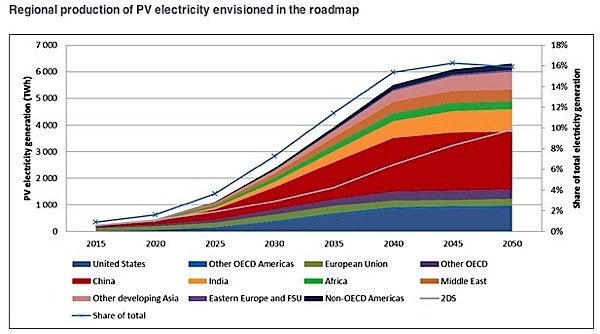Solar energy could provide a greater share of the world’s electricity by 2050 than fossil fuels, wind, hydro and nuclear, according to the International Energy Agency (IEA). Together, photovoltaic systems and solar thermal electricity (STE) could be providing more than a quarter (27 per cent) of the world’s electricity, and at the same time preventing over 6 billion tonnes of CO2 emissions. That is more than all the current energy-related emissions from the United States, the IEA says in a new report.
In 2010, the IEA roadmap for PV deployment set the benchmark of 200 GW of cumulative world capacity by 2020. But this goal will be reached by next year, the report says, fully five years earlier than predicted. That amounts to more solar photovoltaic capacity than was deployed in the previous four decades. The leaders in PV deployment have been China, Japan and the United States.

It is the rapid cost decrease in PV modules in the last few years that accounts for this rapid deployment and for “new perspectives” for the use of solar energy in coming decades, the director of IEA, Maria van der Hoeven, pointed out. That cost is projected to decrease a further 65 per cent by 2050. What is needed, however, is “clear, credible and consistent signals” from policy makers, to inspire confidence and reduce deployment risk for investors. Both technologies are capital intensive, the report notes, so that lowering the cost of capital is of “primary importance” for achieving the targets in the current roadmap.
Van der Hoeven urges governments to take a long-term approach to solar energy, setting up long-term targets for solar electricity that take account of the cost reductions. Governments will also have to create “market designs” that look at the whole system, considering the impacts of distributed generation from residential and commercial PV rooftops on the rest of the grid. As more and more consumers install rooftop solar and buy less and less electricity from the utility company, what will the utility have to do to stay profitable?
This is already a contested issue in some jurisdictions, where utilities are demanding an end to the rules that require them to pay market value for privately generated electricity. As customer-sited photovoltaics become more abundant, older utilities could see their revenues decline relative to the costs of purchasing and distributing the extra electricity. This could put them in financial troubles, as a new study from Lawrence Berkeley National Laboratory points out (Financial Impacts of Net-Metered PV on Utilities and Ratepayers). One scenario in the Berkeley study estimates that if rooftop solar reached 10 per cent of the market, utility earnings could fall by as much as 41 per cent.































